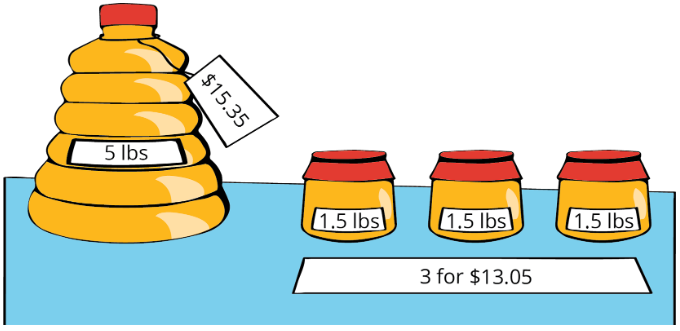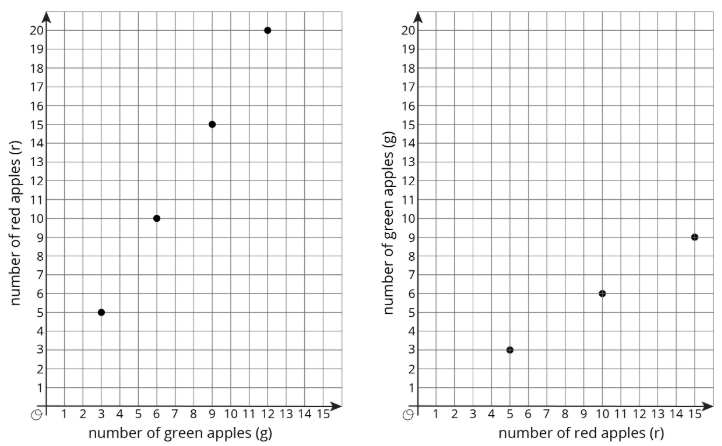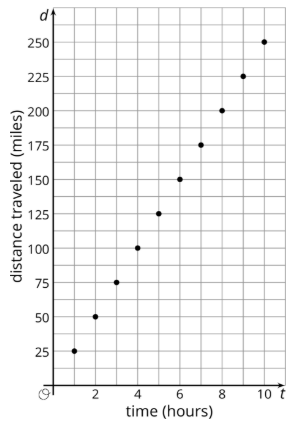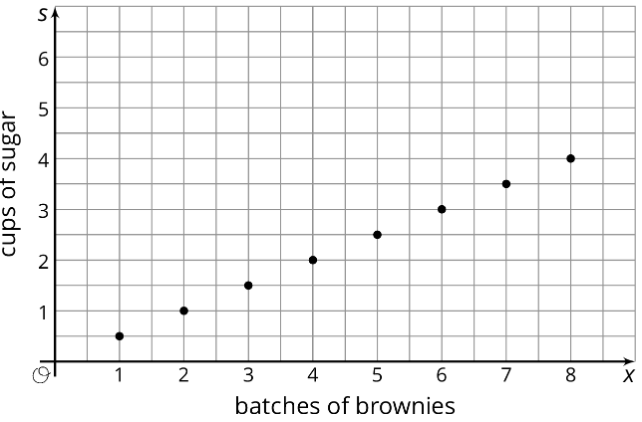34.1: Two Related Quantities, Part 1
- Page ID
- 40620
Lesson
Let's use equations and graphs to describe relationships with ratios.
Exercise \(\PageIndex{1}\): Which One Would You Choose?
Which one would you choose? Be prepared to explain your reasoning.
- A 5-pound jug of honey for $15.35
- Three 1.5-pound jars of honey for $13.05

Exercise \(\PageIndex{2}\): Painting the Set
Lin needs to mix a specific shade of orange paint for the set of the school play. The color uses 3 parts yellow for every 2 parts red.
- Complete the table to show different combinations of red and yellow paint that will make the shade of orange Lin needs.
cups of red paint (\(r\)) cups of yellow paint (\(y\)) total cups of paint (\(t\)) \(2\) \(3\) \(6\) \(20\) \(18\) \(14\) \(16\) \(50\) \(42\) Table \(\PageIndex{1}\) - Lin notices that the number of cups of red paint is always \(\frac{2}{5}\) of the total number of cups. She writes the equation \(r=\frac{2}{5}t\) to describe the relationship. Which is the independent variable? Which is the dependent variable? Explain how you know.
- Write an equation that describes the relationship between \(r\) and \(y\) where \(y\) is the independent variable.
- Write an equation that describes the relationship between \(y\) and \(r\) where \(r\) is the independent variable.
- Use the points in the table to create two graphs that show the relationship between \(r\) and \(y\). Match each relationship to one of the equations you wrote.
Are you ready for more?
A fruit stand sells apples, peaches, and tomatoes. Today, they sold 4 apples for every 5 peaches. They sold 2 peaches for every 3 tomatoes. They sold 132 pieces of fruit in total. How many of each fruit did they sell?
Summary
Equations are very useful for describing sets of equivalent ratios. Here is an example.
A pie recipe calls for 3 green apples for every 5 red apples. We can create a table to show some equivalent ratios.
We can see from the table that \(r\) is always \(\frac{5}{3}\) as large as \(g\) and that \(g\) is always \(\frac{3}{5}\) as large as \(r\).
| green apples (\(g\)) | red apples (\(r\)) |
|---|---|
| \(3\) | \(5\) |
| \(6\) | \(10\) |
| \(9\) | \(15\) |
| \(12\) | \(20\) |
Table\(\PageIndex{2}\)
We can write equations to describe the relationship between \(g\) and \(r\).
- When we know the number of green apples and want to find the number of red apples, we can write:
\(r=\frac{5}{3}g\)
In this equation, if \(g\) changes, \(r\) is affected by the change, so we refer to \(g\) as the independent variable and \(r\) as the dependent variable.
We can use this equation with any value of \(g\) to find \(r\). If 270 green apples are used, then \(\frac{5}{3}\cdot (270)\) or 450 red apples are used.
- When we know the number of red apples and want to find the number of green apples, we can write:
\(g=\frac{3}{5}r\)
In this equation, if \(r\) changes, \(g\) is affected by the change, so we refer to \(r\) as the independent variable and \(g\) as the dependent variable.
We can use this equation with any value of \(r\) to find \(g\). If 275 red apples are used, then \(\frac{3}{5}\cdot (275)\) or 165 green apples are used.
We can also graph the two equations we wrote to get a visual picture of the relationship between the two quantities.

Glossary Entries
Definition: Dependent Variable
The dependent variable is the result of a calculation.
For example, a boat travels at a constant speed of 25 miles per hour. The equation \(d=25t\) describes the relationship between the boat's distance and time. The dependent variable is the distance traveled, because \(d\) is the result of multiplying 25 by \(t\).

Definition: Independent Variable
The independent variable is used to calculate the value of another variable.
For example, a boat travels at a constant speed of 25 miles per hour. The equation \(d=25t\) describes the relationship between the boat's distance and time. The independent variable is time, because \(t\) is multiplied by 25 to get \(d\).

Practice
Exercise \(\PageIndex{3}\)
Here is a graph that shows some values for the number of cups of sugar, \(s\), required to make \(x\) batches of brownies.

- Complete the table so that the pair of numbers in each column represents the coordinates of a point on the graph.
\(x\) \(1\) \(2\) \(3\) \(4\) \(5\) \(6\) \(7\) \(s\) Table \(\PageIndex{3}\) - What does the point \((8,4)\) mean in terms of the amount of sugar and number of batches of brownies?
- Write an equation that shows the amount of sugar in terms of the number of batches.
Exercise \(\PageIndex{4}\)
Each serving of a certain fruit snack contains 90 calories.
- Han wants to know how many calories he gets from the fruit snacks. Write an equation that shows the number of calories, \(c\), in terms of the number of servings, \(n\).
- Tyler needs some extra calories each day during his sports season. He wants to know how many servings he can have each day if all the extra calories come from the fruit snack. Write an equation that shows the number of servings, \(n\), in terms of the number of calories, \(c\).
Exercise \(\PageIndex{5}\)
Kiran shops for books during a 20% off sale.
- What percent of the original price of a book does Kiran pay during the sale?
- Complete the table to show how much Kiran pays for books during the sale.
- Write an equation that relates the sale price, \(s\), to the original price \(p\).
- On graph paper, create a graph showing the relationship between the sale price and the original price by plotting the points from the table.
| original price in dollars (\(p\)) | sale price in dollars (\(s\)) |
|---|---|
| \(1\) | |
| \(2\) | |
| \(3\) | |
| \(4\) | |
| \(5\) | |
| \(6\) | |
| \(7\) | |
| \(8\) | |
| \(9\) | |
| \(10\) |
Exercise \(\PageIndex{6}\)
Evaluate each expression when \(x\) is \(4\) and \(y\) is \(6\).
- \((6-x)^{3}+y\)
- \(2+x^{3}\)
- \(2^{x}-2y\)
- \(\left(\frac{1}{2}\right)^{x}\)
- \(1^{x}+2^{x}\)
- \(\frac{2^{x}}{x^{2}}\)
(From Unit 6.3.4)
Exercise \(\PageIndex{7}\)
Find \((12.34)\cdot (0.7)\). Show your reasoning.
(From Unit 5.3.4)
Exercise \(\PageIndex{8}\)
For each expression, write another division expression that has the same value and that can be used to help find the quotient. Then, find each quotient.
- \(302.1\div 0.5\)
- \(12.15\div 0.02\)
- \(1.375\div 0.11\)
(From Unit 5.4.5)

